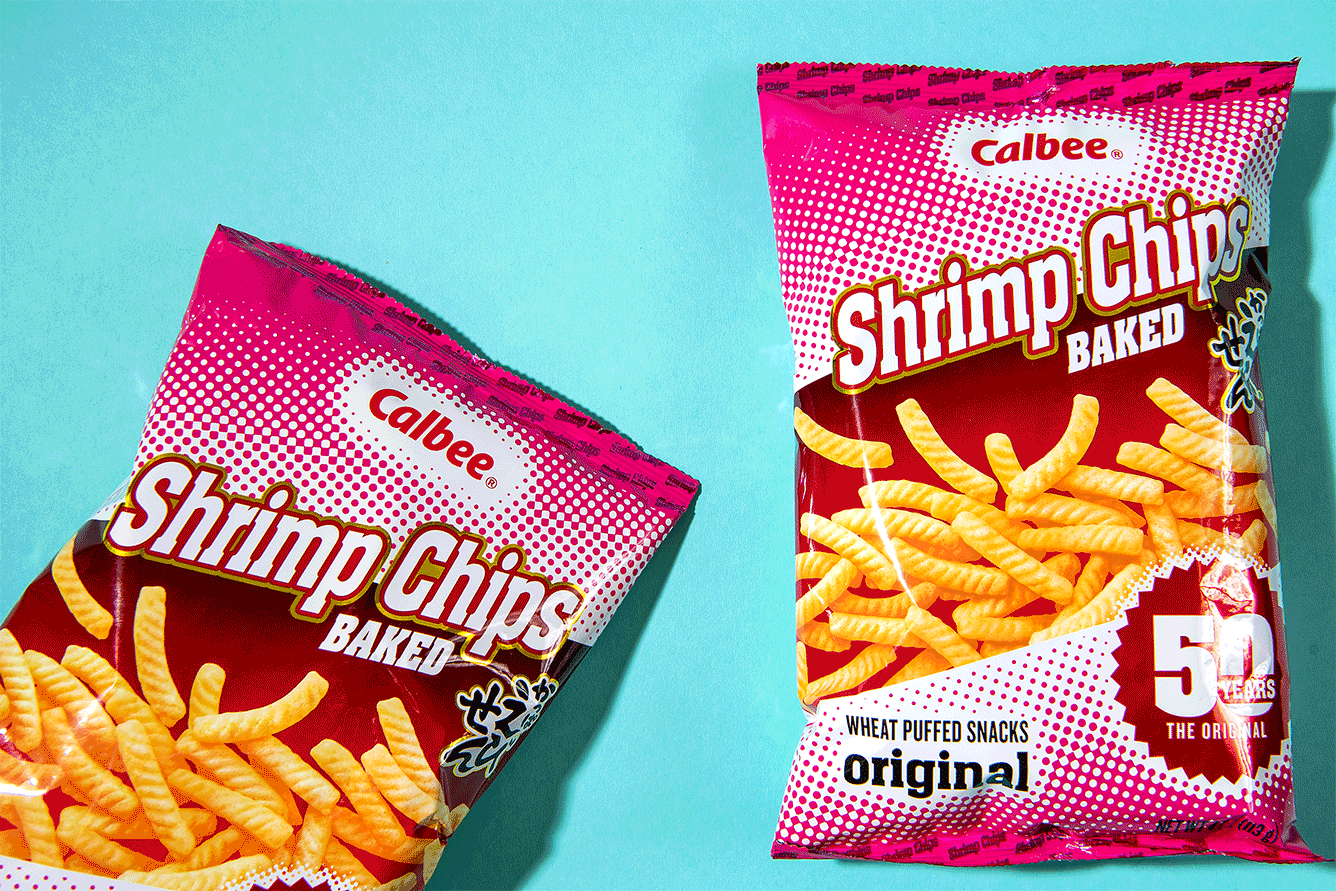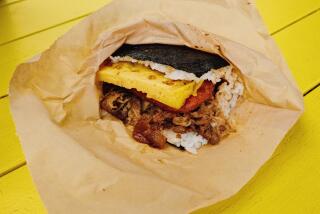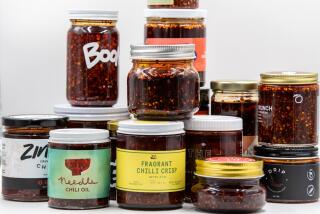Calbee Shrimp Chips have a cult following. Here’s how it happened

- Share via
When Cynthia Chen posted photos of rugs she’d crafted based on her favorite Asian snacks — Calbee Shrimp Chips among them — Twitter noticed.
Chen, a Chinese American product designer in San Francisco, says the snacks were always around when she was growing up; she recalls sharing them with her grandmother and father. When she picked up punch needle embroidery as a hobby and replicated Calbee’s iconic pink polka-dotted bag on a rug, she didn’t expect much. But her December tweet has garnered nearly 60,000 likes.
“It was a cool moment to see how all of these other people love shrimp chips,” said Chen. “In my head, it was just something I grew up with, but it was very relatable to people.”
Calbee Shrimp Chips, a savory wheat-based snack made with shrimp — and a lot of standard snack ingredients like salt, sugar and cornstarch — are ubiquitous in the aisles of Asian markets in the United States. In Japan, Calbee is as recognizable as Lay’s is to Americans. The longevity of the Calbee brand and its shrimp chips (created in 1964, the same year as the first Tokyo Summer Olympics) and its growing international reach have played a role in the growth of the Asian snack import market, which has soared in the last few decades.
Takashi Matsuo founded Calbee (originally called the Matsuo Food Processing Co.) in 1949, during the devastating aftermath of World War II. He started the company in Hiroshima, his hometown, and had firsthand knowledge that the Japanese people were suffering from severe food shortages.
Calbee America Inc. brand manager Ayumi Tsurushita says Matsuo hoped his snacks could help supplement the diets of the people in his country. (Calbee is a portmanteau of “calcium” and “vitamin B-1.” However, Tsurushita said Calbee doesn’t claim that its products are healthy or nutritious; a 1-ounce serving contains 2% of the recommended daily value of calcium.)
“Calbee’s foundation is really [built] upon the founder’s philosophy of using untapped food resources,” Tsurushita said.
Calbee’s first product was caramel, made from mixed grains and Japanese yam starch. The company moved away from candy with the 1955 creation of a wheat version of a Japanese rice cracker called Kappa Arare. It was a hit, and that success led Matsuo to develop other wheat-based snacks, one of which was Kappa Ebisen ( a.k.a. shrimp chips).
Matsuo, a skilled shrimper who loved his mother’s shrimp tempura, put his stamp on the snack world with crustaceans. He used freshly caught, whole shrimp that were minced and kneaded into a dough that was, in turn, dried into pellets, which were then baked and seasoned.
That dough was made with wheat flour because rice and rice flour were expensive, and production was limited in Japan in the 1950s and ‘60s. Matsuo imported wheat flour from the United States and figured out how to produce snacks that have a similar texture and taste to rice flour products.
While there were other snack companies that emerged after the war, Calbee led the charge and Shrimp Chips added to its prominence. In 1967, the snack accounted for about $9 million in sales in Japan; by 1970, that figure grew to about $91 million.
Its popularity was fueled in part by a 1969 Calbee TV commercial with a catchy tagline — “yamerarenai tomaranai” — or “can’t quit, can’t stop.” The company still uses the catchphrase.
Tomoko Imade Dyen, a Los Angeles-based Japanese food researcher who runs the Japanese Food Ambassador YouTube channel, remembers the commercials from her childhood in Japan. “Every kid — from my generation, like anyone who is over 40 — probably knows [the] tune from the TV commercials,” she said, adding that Calbee Shrimp Chips were a staple in school lunchboxes. “Even adults [liked them]: I remember my grandparents eating them with us.”
After establishing the product in Japan, the next step for Calbee was bringing the product to the United States, where in 1967 Matsuo exhibited the shrimp chips at the Fancy Food Show international food expo in New York. Japanese news outlets published positive reports with headlines like “Calbee’s Kappa Ebisen was a showstopper.”
Matsuo founded Calbee America Inc., its first international venture, in 1970 with its first office in Buena Park. (The U.S. headquarters are now in Fairfield in Northern California.) “At that time, [Calbee Shrimp Chips] didn’t have a big market like it does today,” said Takashi Katsunoi, a national sales manager at Calbee America Inc. It wasn’t until the 1980s, he said, when the Asian population was growing in the United States, that Calbee started distributing its products more widely.
Americans consumed 6.7 million bags of Calbee Shrimp Chips in 2020, up from 4.4 million bags in 2014. California, which has a large Asian population, is Calbee’s biggest U.S. market.
Calbee has expanded into other flavors, including hot garlic, yuzu and black pepper, and wasabi. This month, the company will launch a sriracha mayo version. (Other companies like Korean brand Nongshim have created similar products with the same target audience in mind.)
Soy Nguyen, whose TikTok account FoodwithSoy has more than 600,000 followers, has made videos about her love for Asian snacks including Nongshim Shrimp Crackers and wasabi-flavored Calbee Shrimp Chips.
Nguyen isn’t loyal to any particular brand, but shrimp chips are nostalgic for her because her mother would always pick them up from grocery stores when she was growing up.
“There’s this special umami taste to it from the shrimp, and it’s always crispy even if you leave the bag slightly open for a couple of hours,” Nguyen said.
A couple of years ago, Bettina Makalintal, now an associate editor at Bon Appetit, wrote a love letter to Calbee Shrimp Chips for Vice under the headline “Calbee Shrimp Chips Are a Food Science Marvel — and No, I Don’t Want to Share.”
“Calbee Shrimp Chips are my No. 1 chips snack,” Makalintal said in an interview. “If I go to a store and I can choose anything on the shelves and it’s completely well stocked, it’s always the first thing I’ll go to. I love seaweed, salt, and anything that has MSG.”
Makalintal has memories of eating the chips with her family during the ride home from Asian grocery stores. “I always remembered that they would have a strong seafood-y smell that was definitely more pronounced from being in the enclosed space of a car,” she said.
The chips have a cult following, and fans like to get creative with their consumption. Nguyen puts shrimp chips in sandwiches for added crunch. Katsunoi said people in Japan will mix soy sauce with mayonnaise and use that as a dipping sauce. Calbee America Inc. president Mio Sakata says a friend who is a French chef would freeze shrimp chips, add sriracha to the bag and shake it — and then eat them cold.
Calbee has since developed other product lines in Japan, including Jagarico potato sticks and Frugra granola. Its Sayaendo green pea crisps were rebranded in the U.S. as Harvest Snaps, with flavors like Caesar and white cheddar developed to appeal to American palates.
Sakata explains that in Japan, where the items on 7-Eleven snack shelves change every two weeks, the competition to create new flavors is fierce. The parent company produces 400 to 500 new products each year (many of them new flavors for already existing products). And while Calbee says it doesn’t keep track of how many of its products are successful, Takuro Tatsumi, Calbee America Inc.’s associate director of category development, said three out of 1,000 new products will succeed in the Japanese food industry.
The Asian snack import market in the United States is expanding rapidly. Yami, a leading online Asian foods retailer in the United States, has been operating since 2013 and is seeing that increase in demand.
“I think demand is [coming] from two sides,” said Alex Zhou, Yami founder and chief executive officer. The number of Asian immigrants and international students from Asian countries has largely grown over recent years, and the mainstream market is taking an interest in Asian snacks.
When Zhou started Yami (originally known as Yamibuy) eight years ago, his company generated $2 million in revenue the first year; since 2018, it has generated hundreds of millions of dollars annually, and growth has been more than 100% each year. Half of his sales are from Asian snacks.
“I do believe the future of Asian snacks is that they are for everybody,” Zhou said. “We just have the tastiest products in the world.”
More to Read
Eat your way across L.A.
Get our weekly Tasting Notes newsletter for reviews, news and more.
You may occasionally receive promotional content from the Los Angeles Times.










